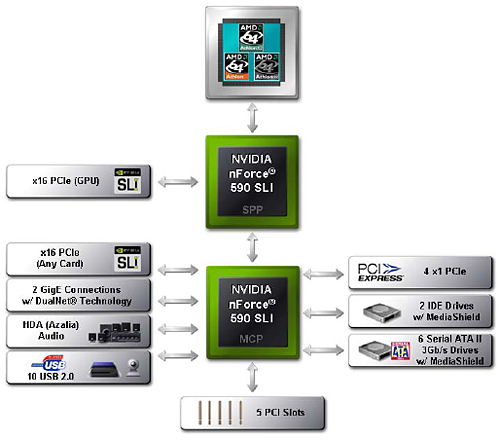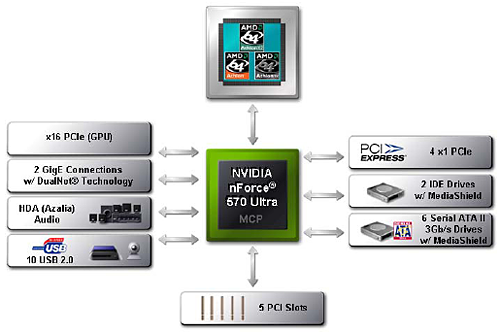nForce 500: nForce4 on Steroids?
by Gary Key & Wesley Fink on May 24, 2006 8:00 AM EST- Posted in
- CPUs
Basic Features: nForce 500 Platform
For the launch of socket AM2, NVIDIA is providing no less than four new product offerings dependent upon the market sector. With this product introduction NVIDIA is launching two new chipsets, the C51XE and MCP55PXE that form the basis for the four models. A quick summary of the new product choices can be found in the following table.| NVIDIA Chipset Breakdown | ||
| Market Segment | Socket 939 | Socket AM2 |
| High-End Enthusiast | nForce4 SLI X16 | nForce 590 SLI |
| Mainstream Enthusiast | nForce4 SLI | nForce 570 SLI |
| Performance Mainstream | nForce4 Ultra | nForce 570 Ultra |
| Value Mainstream | nForce4 4X | nForce 550 |
We expect the new socket AM2 motherboards to cost slightly more than their socket 939 counterparts, at least initially, but long-term they should have basically the same prices. The High-End Enthusiast segment will be around $200, Mainstream Enthusiast will be around $150, Performance Mainstream will be close to $100, and the Value Mainstream offerings will look to target the $80 or under market.

At the top of the product offering, the nForce 590 SLI consists of two chips, the C51Xe SPP and the MCP55PXE. This solution offers dual X16 PCI-E lanes for multiple graphics card configurations. While other features have changed, the overall design is very similar to the nForce4 SLI X16. The total number of PCI-E lanes is now 46, with 18 lanes coming from the SPP. Of those 18, two go unused at present and the remaining 16 are for the PEG slot.

One step down from the nForce 590 SLI is the nForce 570 SLI. This is a single chip solution, providing two X8 lanes for multiple graphics cards. A total of 28 lanes are of available, up from the 20 lanes that were available on the nForce4 SLI chipset. The 570 chipset also lacks the included LinkBoost technology but is otherwise the same as the 590.

The nForce 570 Ultra comes next, with a drop to 20 total PCI-E lanes. If the name didn't clue you in already, the Ultra also drops support for SLI. Basically, this is the "performance mainstream" offering, targeting users that are only interested in running single graphics cards. We do not expect a large difference in price between the 570 SLI and the 570 Ultra boards, and the $20 or so price premium might be worthwhile in order to have the extra PCI-E X16 slot. While at present only cards going into X16 slots are GPUs, depending on how long do you keep your next motherboard you might see additional options.

Rounding out the chipset offerings, the nForce 550 is the "value mainstream" product, taking over from the nForce4 4X. Several of the higher end options have been dropped from the 550 chipset, including support for dual Ethernet controllers, the FirstPacket technology, TCP/IP acceleration, and RAID 5. The number of natively supported SATA ports has also been reduced from six down to four. Whereas the other three chipsets are recommended for Athlon 64/FX/X2 users, the nForce 550 is recommended for Athlon 64 (single core) and Sempron users.
Here's a summary of the features and specifications of each chipset:
| Specification | |||||
| NVIDIA nForce 590 SLI |
NVIDIA nForce 4 SLI x16 |
NVIDIA nForce 570 SLI |
NVIDIA nForce 570 Ultra |
NVIDIA nForce 550 |
|
| Segment | Enthusiast SLI (2x16) |
Enthusiast SLI (2x16) |
Performance SLI (2x8) |
Performance | Mainstream |
| CPU Suggestion | Athlon 64 FX, Athlon 64 | Athlon 64 FX, Athlon 64 | Athlon 64 FX, Athlon 64 | Athlon 64 FX, Athlon 64 | Athlon 64, Sempron |
| SLI Technology | Yes | Yes | Yes | No | No |
| NVIDIA LinkBoost | Yes | No | No | No | No |
| NVIDIA FirstPacket | Yes | No | Yes | Yes | No |
| NVIDIA DualNet | Yes | No | Yes | Yes | No |
| Gigabit Connections | 2 | 2 - requires an external chipset | 2 | 2 | 1 |
| Teaming | Yes | No | Yes | Yes | No |
| TCP/IP Accleration | Yes | Yes, ActiveArmor | Yes | Yes | No |
| MediaShield | Yes | Yes | Yes | Yes | Yes |
| SATA / PATA Drives | 6 SATA 2 PATA |
4 SATA 4 PATA |
6 SATA 2 PATA |
6 SATA 2 PATA |
4 SATA 2 PATA |
| RAID | 0, 1, 0+1, 5 | 0, 1, 0+1 | 0, 1, 0+1, 5 | 0, 1, 0+1, 5 | 0, 1, 0+1 |
| NVIDIA nTune 5 | Yes | No | Yes | Yes | Yes |
| PCI Express Lanes | 46 | 38 | 28 | 20 | 20 |
| Links | 9 | 8 | 6 | 5 | 5 |
| USB Ports | 10 | 10 | 10 | 10 | 10 |
| PCI Slots Supported | 5 | 5 | 5 | 5 | 5 |
| Audio | Azalia | AC'97 | Azalia | Azalia | Azalia |










64 Comments
View All Comments
ayqazi - Wednesday, July 5, 2006 - link
I'm a little tired of hearing about so-called "chipset" hardware RAID. The writer of this article constantly made it seem that it was the chipset that was responsible for performing RAID operations on the disks, whereas nothing could be farther from the truth.Yes, the chipset may offload some of the work, but (in the case of RAID 5) the major calculations, like the XOR calculations, are done by the host processor.
According to [L]http://linuxmafia.com/faq/Hardware/sata.html#faker...[/L] and [L]http://spamaps.org/raidtests.php[/L], Linux-based software raid is much faster than so-called fakeraid, since it has been optimised and developed more than the software drivers of the fakeraid chipsets.
Anyway, just pointing out something that gets on my nerves a bit.
raildogg - Saturday, May 27, 2006 - link
I think for most of us who have a nForce 4 ultras and SLIs, it doesn't make sense to upgrade to AM2 motherboards and processors. We'll need new memory too. No performance increase. Just upgrade to a X2 and that should be a good upgrade for those of us who don't have it yet.Powered by AMD - Friday, May 26, 2006 - link
When in the article says:"In fact, the less than stellar write performance of the nForce4 in RAID 5 continues in the "new" chipset"
It does mean that the write performance is good or not?
thanks!
Zoomer - Saturday, May 27, 2006 - link
Means just as bad as before, in a nicer manner. :)Gary Key - Saturday, May 27, 2006 - link
Thank you for the perfect reply. ;-) NVIDIA is working on this for the next refresh, their reasoning at this time is they did not want to introduce potential data corruption issues by improving the performance with the current chipset and driver base. It continues to reinforce our belief that although the nF590 SLI is the most feature laden chipset out at this time, the core continues to be nForce4 Plus in our eyes. This is not bad at all, just what can you do with a less than stellar CPU release (still an extremely strong CPU lineup) from a marketing viewpoint. I think NVIDIA and ATI are going to be hamstrung on sales with the AM2 release but hopefully they can make it up when Conroe (Core 2 Duo) launches shortly. :) The bios revisions we have received this week have improved performance but nothing that would make a nf4SLI/4800+ owner want to upgrade yet.
SonicIce - Wednesday, May 24, 2006 - link
AM2 can just die.afrost - Thursday, May 25, 2006 - link
i'm glad you took the time to type all that out.....KHysiek - Thursday, May 25, 2006 - link
Well, but it does say precisely right about the whole AM2 transition.This is the most pointless hardware upgrade I've seen forfew last years.
The only significant advantage of AM2 is a bit more featured mainboard. And you pay more for less speed. I think AMD is on the way down and no K8L can save them, cause it will be quad core only. What typical user needs quad core for price AMD keeps (like their pricing for current X2 CPU's versus Intel's).
Core 2 is huge leap forward and combined with Intel manufacturing power will make big push back for AMD in coming months.
Pirks - Wednesday, May 24, 2006 - link
Gary, what's about that QoS network driver/protocol hanging around in my WinXP for years? I heard it does some quality of service stuff/packet prioritizing/etc soo... is FirstPacket just an interface for this Microsoft QoS thing? Or is nVidia didn't know about it and reinvented the wheel?Gary Key - Wednesday, May 24, 2006 - link
I raised this question at the Editor's conference as it appeared to me they decided to take advantage of some hooks/protocols in XP. I have a meeting with the platform manager tomorrow and hopefully some discussions with the Network guru next week after his return from vacation. I am trying to get an answer before our roundup is published. I noticed some interesting inter-actions during our network testing, will say this, they (NVIDIA) really took the networking side seriously on this release although most of the features are designed for the server/workstation market, but we get them for free on the desktop. We expect further hardware/driver improvements in the next refresh. I am trying to compare the outbound FirstPacket numbers to a D-Link Gamer Lounge at this time along with how both prioritize packets on the outbound lanes. There are so many different tests and options in just the new networking features to run that is a bit overwhelming at this point and of course the new draft-N equipment showed up this week also. ;-)